Canna: planting, growing and care
 Canna (lat. Canna) is the genus in the monotypic family Cannaceae (Latin Cannaceae) of the order Zingiberales, including more than fifty species of herbaceous plants. In nature they grow in Central and South America, India and China. It was brought to Europe by Portuguese sailors in the 16th century, but cultivation of cannas was began only in the 17th century. The name originates from the Greek word “cana” meaning “reed”. And as a matter of fact, the canna stalk resembles this plant.
Canna (lat. Canna) is the genus in the monotypic family Cannaceae (Latin Cannaceae) of the order Zingiberales, including more than fifty species of herbaceous plants. In nature they grow in Central and South America, India and China. It was brought to Europe by Portuguese sailors in the 16th century, but cultivation of cannas was began only in the 17th century. The name originates from the Greek word “cana” meaning “reed”. And as a matter of fact, the canna stalk resembles this plant.
The Latin word “cana” means “pipe”, and the ancient legend says that the flowers of canna grew on the site of a fire in which one of the Indian chiefs burned a wampum wrapped in a tube with a peace treaty, thus provoking a bloody war and bright red petals of cannas looked like the tongues of that fire or the blood shed in that war. For the flower growers, the value of canna is not only in its beautiful flowering, but also in large ornamental leaves of dark green, dark purple, red-bronze and even purple hues.
Features of canna flowers
At first glance, the canna flower is like a banana hybrid with a gladiolus or orchid. There are two disadvantages of the plant: in cold climate zones it overwinters badly in the open ground and does not have a fragrance at all. All other characteristics are solid advantages. The most valuable of them is the plant is insusceptible to diseases, so growing of canna will not be troublesome even for a beginner flower grower. Canna, for all its ornamental beauty in general, is an easy-to-grow plant, drought-resistant, and decorates the garden with its flowering from the end of June till the very frosts.
 The rhizome of canna is branching and expanding in breadth. Flower stems are upright, thick, high (from 2 to 10 ft). The leaves are large, strong, pointed, oblong or elliptical, reach a length of 0.8-2.6 ft, and a width of 4-11.8 inches. The shape and color of the leaves make the plant look attractive even when it is not flowering, but only when canna starts blooming, you will understand what beauty and harmony are. The flowers are sharply asymmetric, hermaphrodite, 1.6-3 inches in size, the original color is red, but today, thanks to the work of breeders, there are varieties with yellow, pink, orange flowers that can be bicolored, with a trim and even speckled. White cannes are the rarest. Flowers are collected in paniculate or racemose inflorescences. The fruit is a trilocular capsule.
The rhizome of canna is branching and expanding in breadth. Flower stems are upright, thick, high (from 2 to 10 ft). The leaves are large, strong, pointed, oblong or elliptical, reach a length of 0.8-2.6 ft, and a width of 4-11.8 inches. The shape and color of the leaves make the plant look attractive even when it is not flowering, but only when canna starts blooming, you will understand what beauty and harmony are. The flowers are sharply asymmetric, hermaphrodite, 1.6-3 inches in size, the original color is red, but today, thanks to the work of breeders, there are varieties with yellow, pink, orange flowers that can be bicolored, with a trim and even speckled. White cannes are the rarest. Flowers are collected in paniculate or racemose inflorescences. The fruit is a trilocular capsule.
Varieties of cannas
Indian shot (Canna indica)
Today the ancestor of almost all popular types of cannas is edible canna, or Indian shot (Canna indica). Культурные Varieties of cannasы индийской, полученные в результате многолетней селекции, получили название канна садовая. Цветоводы разделяют эти гибриды на три группы:
Crozy group cannas
is a low-growing species (2-5.2 ft), flowers of which resemble gladioli. Covered with white coating, the leaves have a dark green or purple-bronze hue, the petals of the flowers are bent. The first hybrid was created by a French breeder Crozy in 1868, and this garden canna was named Crozy canna or French canna. The best varieties of Crozy canna are: Livadia up to 3.3 ft high, with red and crimson inflorescences 10-11.8 inches long, the leaves are purple, it starts blooming in July), America (4-4.6 ft tall, cinnabar-red flowers 4.7 inches in diameter, the inflorescence are 11.8-13.7 inches, the leaves are violet, flowering begins in July), President (up to 3.3 ft high, the inflorescences with bright red flowers are about 11.8 inches long, the leaves are green, it starts blooming in July), etc.

Orchid-like group cannas
The shape of the flower resembles Cattleya. These are tall varieties (3.3-6.6 ft) with large flowers (5-6.8 inches) the petals of which have wavy edges. The leaves are green or violet-green. Popular varieties are: Andenken an Pfitzer (3.6-4.6 ft high, the inflorescences are up to 11.8 inches long consisting of bright orange flowers with red strokes, the leaves are brownish-purple, blooming starts in July), Suevia (its height is up to 3.3 ft, the flowers are lemon-colored, the inflorescence is 4.7x6 inches, the leaves are green, its flowering starts in late June), Richard Wallace (up to 3.3 ft high, the flowers are light yellow with red dots collected in the inflorescence 7.8-9 inches long, the leaves are green, it blooms in July), etc.
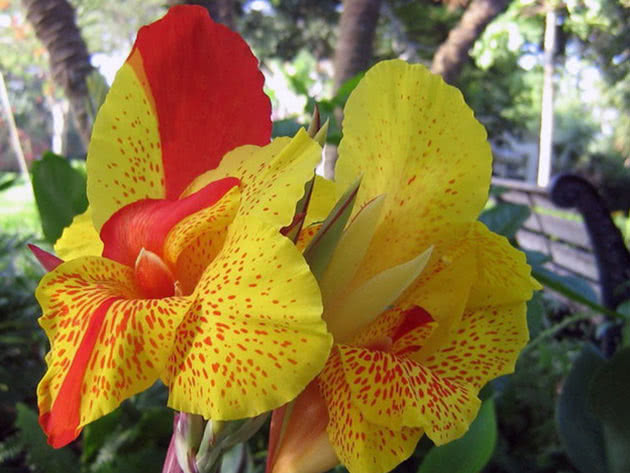
Foliage (small-flowered) group cannes
It reaches 9.8 ft in height. They have very beautiful leaves of green, purple and violet-green colors, but the flowers of these cannas are small, the size does not exceed 2.4 inches, they are rarely cultivated. The most famous variety of foliage canna is Durban: (it has a yellow-orange flower, striped leaves of a pink-bronze-yellow-green color) and it is a true ornament of any garden.
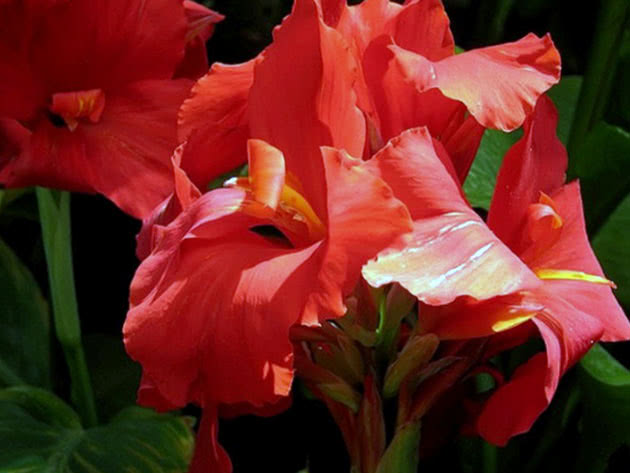
Canna growing in the garden
Sowing canna seeds
Often canna seeds do not retain their varietal qualities, besides not all varieties produce seeds, so the best way to breed cannas is to divide the rhizome. But if you are passionate about breeding, you can try a seed propagation. Canna seeds have a very hard shell that must be softened before sowing. Scald the seeds with boiling water and keep them in a thermos with warm water for 3-4 hours. Or leave them on a hot battery for 12 hours. Or place them in a refrigerate for 1-2 hours. It is necessary to sow the seeds in February, the soil should be light, the temperature is 72-73ºF, in a room there should be a partial shade. The shoots appear in 3-4 weeks, and when they have 3-4 leaves, they should be pricked out into separate pots, the temperature should be kept at 61ºF until their planting out in the soil. Some seedlings may start blooming in the current year, and some will bloom only in the next year.

If you need the most reliable way to get blooming cannas in summer, then in early March divide the rhizomes of canna so that on each section there will be one large bud or a few weak ones, the cuts are sprinkled with crushed charcoal and dried. Keeping the sections tightly to each other, place them in the greenhouse pot over the soil (sand), placing the bud horizontally, sprinkle the sand on top and spray them with a warm water from time to time. Germination is carried out at a temperature of 68-75°F, it would be nice to slightly heat the container from below. When there is no enough room for the leaves, transplant them in small pots and place them in a light room with a temperature of no higher than 61ºF so that they get stronger before being planted in the open ground. Water them with a solution of potassium permanganate (31 gr per 2.2 gallons of water) once every 10 days. It is possible not to grow cannas at home, but without this procedure the flowering period will be greatly delayed: if you plant ungerminated tubers in the soil, canna may have no time to bloom.
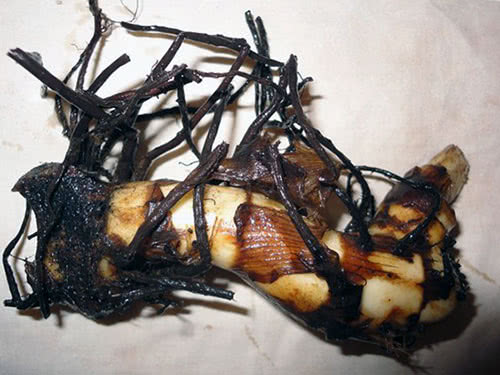
When to plant cannas
When spring frosts pass, you can start preparing a planting site for cannas. Canna thrives in full sun areas protected from drafts. The soil should be fertile, warm and rich in organic matters. The needs of cannas are the same as those of cucumber, a popular vegetable crop. The optimum composition of the soil is as follows: humus, leafy soil, coarse sand and peat in equal parts. Good drainage is a must! When to plant canna? Experienced flower growers advise to do this not earlier than May 9. A sharp temperature drop that sometimes happens in spring can make garden canna lag behind in growth for a long time. At best the flowering time will be delayed, and at worst canna will not bloom at all.
Planting of cannas and care
Planting of cannas in spring
So, in the second half of May, when there is no risk of life-threatening frosts, planting of cannas in the open ground is carried out. If you want to achieve the maximum result from canna, make a hot “bedding” for it: at the bottom of the planting hole with a diameter of 1.6-2 ft, put an 8 inch layer of fresh manure that will give heat to the roots of canna and promote its intensive growth and vigorous flowering, then add a 10 inch layer of soil, moisturize it well and only then put the rhizome of canna in the hole and fill the hole with the soil. If the bulb of canna did not have time to germinate, then the depth of planting should be no more than 2.4-3.5 inches. The distance between the plants, as well as between the rows, should be 20 inches. It takes from one and a half to two months for canna to start blooming after planting.

Care of the garden canna
Two or three times during the vegetation period it is necessary to feed the plant with mineral fertilizers: the granules are sprinkled around the plants after irrigation, and then the soil is loosened. 1.4-1.7 oz of the mixture (0.35 oz of potassium fertilizer, 0.4 oz of nitrogen fertilizer and 0.8 oz of phosphorus fertilizer) per 11 ft ² are required. In other respects, care of canna is very simple. Watering should be regular, but moderate, until the shoots appear. When canna blooms, watering should be more abundant, but do not be over-diligent: excess moistening can cause fungal or bacterial diseases leading to blackening and death of buds. Sometimes canna leaves get damaged by butterfly caterpillars, and the roots get affected by nematodes. You should use insecticides to control them. Do not forget to remove spent inflorescences. In the first half of the growing season, pay attention to the weeds and remove them timely. At the end of flowering and before the first frosts, canna should be earthed up very highly to protect the root collar from a possible frost.
Canna indoors
Growing of canna indoors
Canna has also been successfully grown both as a pot- and tub-gardening plant. At least this concerns those species and varieties that can get placed in the apartment, on the terrace or on the balcony. Home cannas are the center of the floral composition of any winter garden due to their bright ornamental beauty. In addition, home canna only needs a two-month dormancy period, and all the rest of the year it is ready to tirelessly delight your eyes with the beauty of its leaves and flowers. Canna can be grown indoors in a pot like any other houseplant, or you can carefully dig out canna in the garden in autumn and transplant it into a tub or a 20-inch-diameter pot, processing the garden soil with an insecticide in advance to prevent the transfer of insects to the house that could damage the flower.
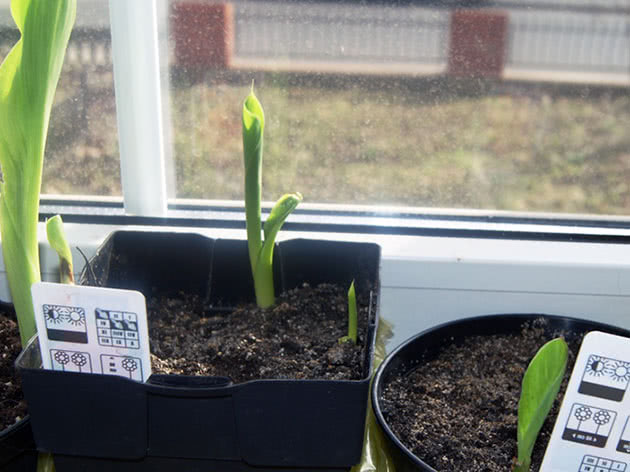
Care of canna indoors
Caring for canna at home is much easier than in the garden: there is no need to spray the plant, to fight with the weeds, to loosen the soil, and to feed the plant. Place it in a well-lit place and water as often as necessary with filtered water, sometimes wiping the leaves with a damp sponge. Even when canna has finished flowering, the leaves will still be bright and beautiful.
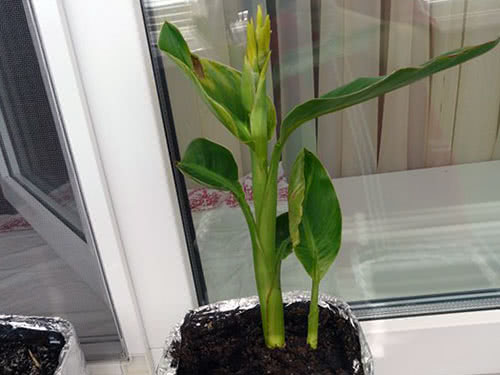
Cannas after flowering
If your home canna has faded and needs rest, gradually reduce watering and stop watering at all. Trim the leaves at a height of 4-6 inches from the ground surface and place the pot in a cool, dry room with a temperature of at least 50°F. In spring, take the rhizome from the ground, divide it, and plant out the sections. You can grow them in the pots at home, take them out on a balcony or plant them in the garden – it's up to you.
Garden cannas after flowering do not need a lot of water, so watering should be gradually reduced until it is completely ceased. Before the first frosts, canna should be earthed up in order to protect the root collars from freezing, otherwise they may start rotting in winter, and immediately after the first frosts canna stems should be cut at a height of 6-8 inches from the ground level, and the rhizomes should be removed together with the clod of soil.
Canna storage in winter
At the end of September and beginning of October cannas are carefully dug out from the ground together with a clod of soil and transferred to a place where they will be stored until spring. In winter cannas should be stored in a cool room with moderate humidity and diffused light. The rhizomes are placed in boxes and covered with peat, sand and soil mixed with sawdust of non-coniferous trees. Humidity level of the substrate should be 50%, and the temperature is 43-46°F. Storing of cannas requires regular inspection to notice the first signs of rotting: if a damaged tuber is found, cut the affected area to get a healthy tissue, and apply iodine to the cut. Maintain the humidity level and protect the rhizomes from a sharp temperature drop.
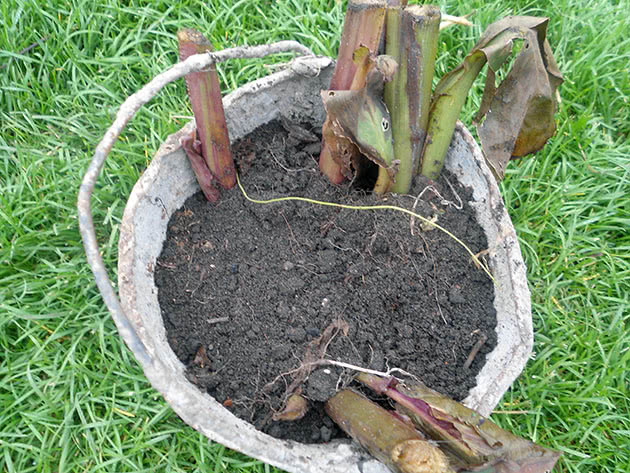
If you do not have the opportunity to store cannas indoors, you can keep them in the fridge until spring. In autumn, the tubers are dug out, washed from the soil under running water, kept in a disinfectant solution of potassium permanganate for 24 hours and then dried. Each piece is wrapped into paper and placed in a container for storing vegetables, from time to time checking if any of the tubers is affected by the rot. Some growers keep the dried tubers of cannas on the balcony in a plastic bucket, sprinkling them with a dry soil. With a strong cooling, the bucket should be brought indoors and placed on the floor near the balcony door.

You can store rhizomes in a pot with the soil at a temperature of no higher than 59°F. For this purpose you can use a glazed loggia, attic or veranda. In this case, the soil needs to be moistened a couple of times a month. If there are no frosty winters in your area, you can store the dug-out canna roots directly on a planting site protected from the wind and excess water. You just need to cover the tubers with an eight-inch layer of dry sawdust.
